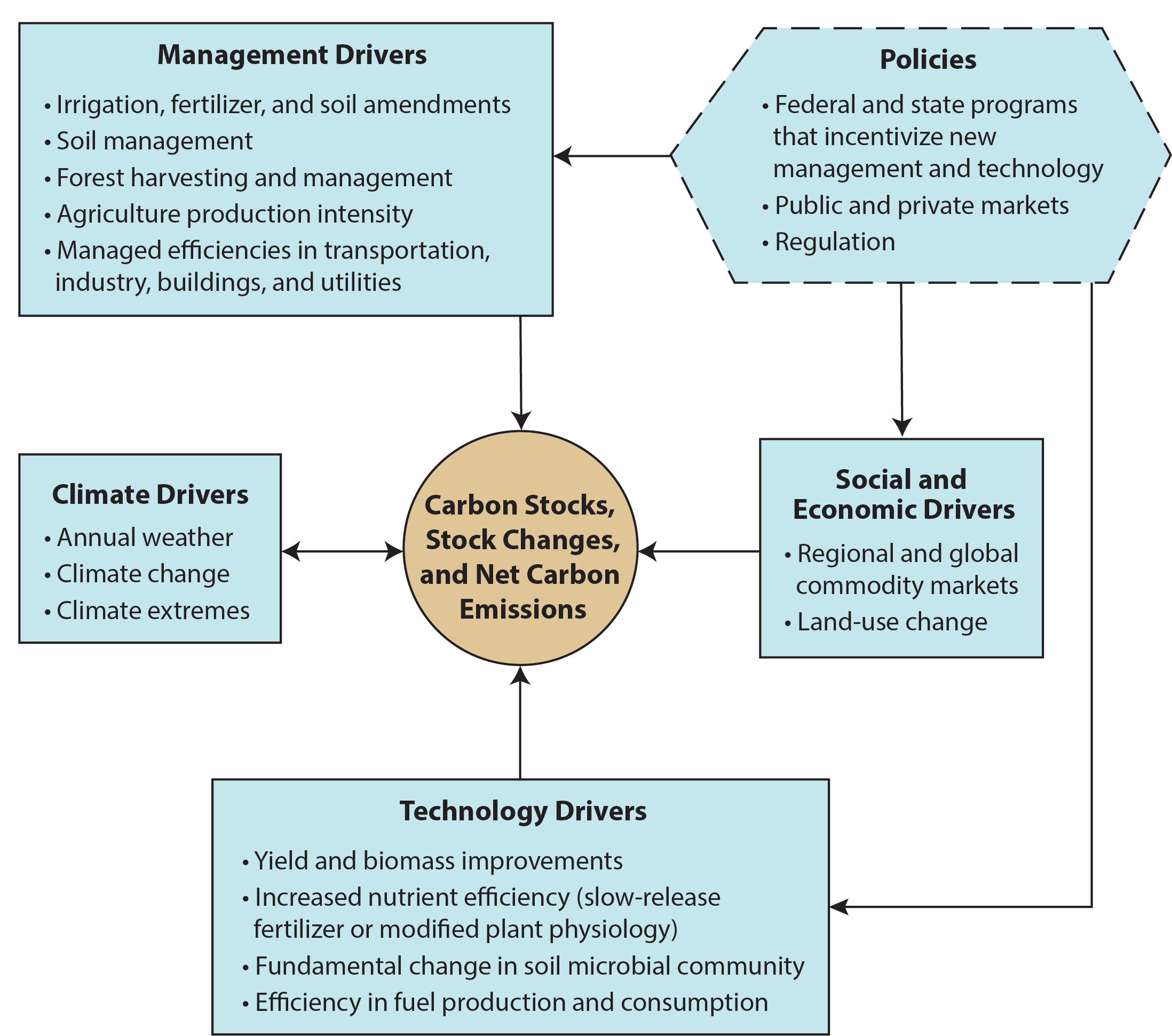Birdsey, R., M. A. Mayes, P. Romero-Lankao, R. G. Najjar, S. C. Reed, N. Cavallaro, G. Shrestha, D. J. Hayes, L. Lorenzoni, A. Marsh, K. Tedesco, T. Wirth, and Z. Zhu, 2018: Executive summary. In Second State of the Carbon Cycle Report (SOCCR2): A Sustained Assessment Report [Cavallaro, N., G. Shrestha, R. Birdsey, M.A. Mayes, R. G. Najjar, S. C. Reed, P. Romero-Lankao, and Z. Zhu (eds.)]. U.S. Global Change Research Program, Washington, DC, USA, pp. 21-40, https://doi.org/10.7930/SOCCR2.2018.ES.
Executive Summary
Carbon is a key element in multiple social, ecological, physical, and infrastructural realms including croplands, grasslands, forests, industry, transportation, buildings, and other structures (see Ch. 3–10). As described in this report, North American social and economic activities, practices, and infrastructures significantly affect the carbon cycle. Energy use predominantly involves burning carbon-based fuels (see Ch. 3: Energy Systems), but society also uses carbon in other less obvious ways such as food and buildings. Carbon is thus embedded in social life (see Ch. 6: Social Science Perspectives on Carbon), and widespread variations in everyday activities result in carbon emissions that cause ripples of intended and unintended social and biophysical effects.
Not only are all parts of the carbon cycle tightly interlinked, they also interact with climate and society in complex ways that are not fully understood (see Figure ES.6 and Ch. 18: Carbon Cycle Science in Support of Decision Making). Given this complexity, a systems approach can provide valuable assistance in identifying mechanisms to reduce carbon emissions to the atmosphere. Such an approach examines carbon comprehensively, holistically, and from an interdisciplinary viewpoint and considers social, economic, and environmental factors as highlighted in examples that follow.
Figure ES.6: Primary Drivers of Carbon Stocks and Emissions in Select Sectors

Energy Systems
System drivers and interactions within the energy sector are particularly complex. Differences in social practices, technical and infrastructural efficiency, market dynamics, policies, waste management, and environmental conditions explain variations in observed levels of energy use and land use, which are two key drivers of carbon emissions across North American households, organizations, firms, and socioecological systems (see Figure ES.6 and Ch. 18). Carbon emissions from burning fossil fuels have decreased because of growth in renewables, new technologies (such as alternative fuel vehicles), rapid increases in natural gas production, the 2007 to 2008 global financial crisis, and more efficient energy production and use (see Figure ES.5; Ch. 2: The North American Carbon Budget; and Ch. 3: Energy Systems). Social mechanisms have influenced carbon emissions through acceptance of rooftop solar energy and wind farms, the dynamics of routines in provision (i.e., attempts by suppliers to encourage and increase demand through marketing), and demand patterns related to the locus of work and the cultural definition of approved practices (see Ch. 6: Social Science Perspectives on Carbon). Although social drivers can lock in dependencies for particular energy systems, North American energy systems are poised for significant infrastructure investment, given the age and condition of transportation infrastructure and existing components for energy generation, transmission, and storage (see Ch. 3: Energy Systems).
Urban Areas
Urban areas occupy only 1% to 5% of the North American land surface but are important sources of both direct anthropogenic carbon emissions and spatially concentrated indirect emissions embedded in goods and services produced outside city boundaries for consumption by urban users (see Ch. 4: Understanding Urban Carbon Fluxes). The built environment (i.e., large infrastructural systems such as buildings, roads, and factories) and the regulations and policies shaping urban form, structure, and technology (such as land-use decisions and modes of transportation) are particularly important in determining urban carbon emissions. Such societal drivers can lock in dependence on fossil fuels in the absence of major technological, institutional, and behavioral change. Moreover, some fossil fuel–burning infrastructures can have lifetimes of up to 50 years. Urban areas also are important sites for policy- and decision-making activities that affect carbon fluxes and emissions mitigation. Co-benefits of urban mitigation efforts can be considerable, particularly in terms of improvements in air quality and human health, as well as reductions in the heat island effect (i.e., elevated ambient air temperatures in urban areas).
Agricultural Practices
Factors driving GHG emissions from agricultural activities include the creation of new croplands from forests or grasslands, nitrogen fertilizer use, and decisions about tillage practices and livestock management. Trends in global commodity markets, consumer demands, and diet choices also have large impacts on carbon emissions through land-use and land-management changes, livestock systems, inputs, and the amount of food wasted (see Ch. 5: Agriculture). Policy incentives and local regulations affect some of these decisions.
Tribal Lands
Carbon cycling and societal interactions on tribal lands have important similarities to and differences from those on surrounding public or private lands. Managing tribal lands and resources poses unique challenges to Indigenous communities because of government land tenure, agricultural and water policies, relocation of communities to reservations in remote areas, high levels of poverty, and poor nutrition. Nevertheless, multiple tribal efforts involve understanding and benefitting from the carbon cycle. For example, there are several case studies examining traditional practices of farming and land management for sequestering carbon on tribal lands (see Ch. 7: Tribal Lands).
Land-Use Change
Land-use change has long been a driver of net reductions in atmospheric CO2 emissions in the United States and Canada. Over the past decade, Canada and Mexico have lost carbon from land-use changes involving forests, but in the United States carbon losses from deforestation have balanced carbon gains from new forestland. Recent increases in natural disturbance rates, likely influenced by climate change and land-management practices, have diminished the strength of net forest uptake across much of North America. In addition, carbon emissions from the removal, processing, and use of harvested forest products offset about half of the net carbon sink in North American forests (see Ch. 9: Forests).
See Full Chapter & References